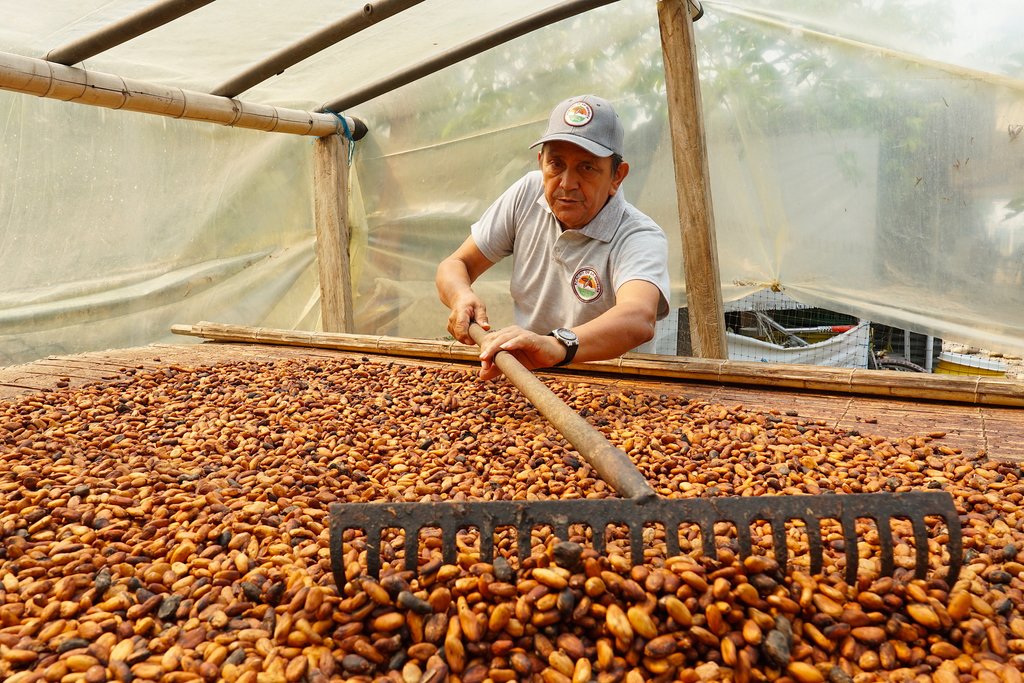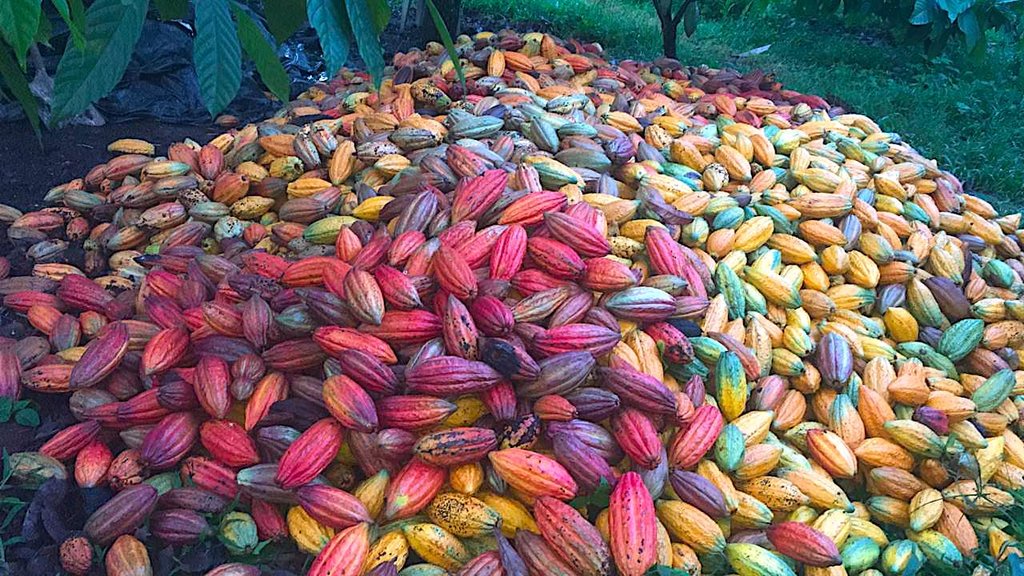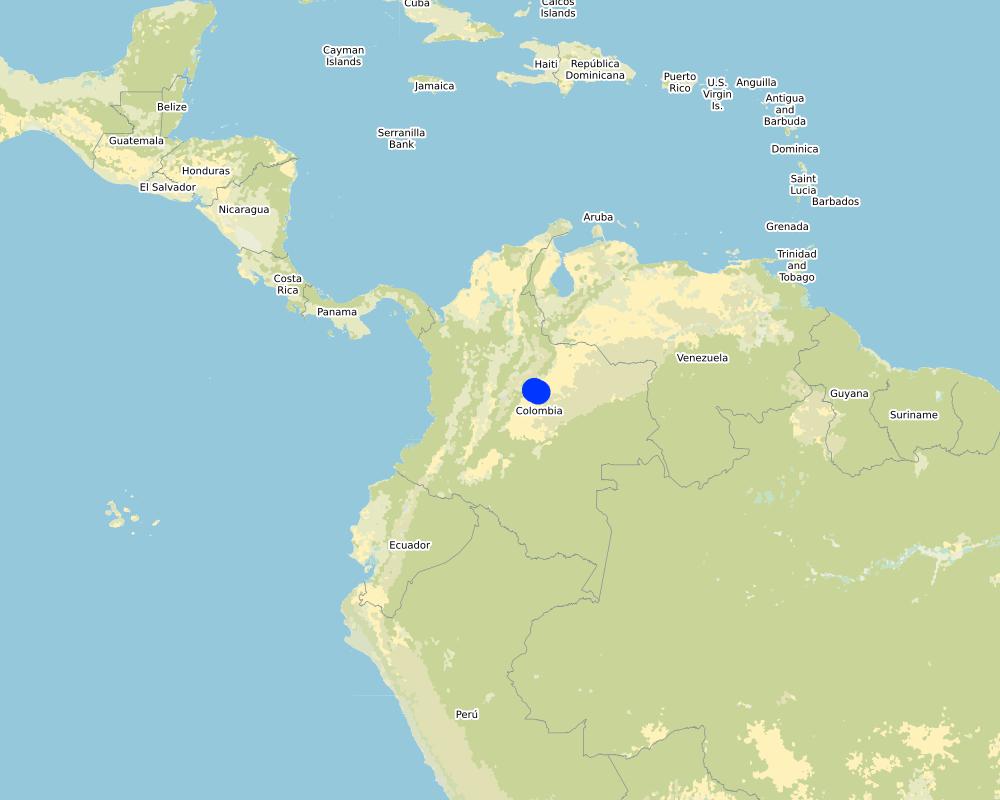Agroforestry system of cacao and gallery forest [Colombia]
- Creation:
- Update:
- Compiler: Luisa F. Vega
- Editor: Hanspeter Liniger
- Reviewer: Hanspeter Liniger
cacao
technologies_5763 - Colombia
View sections
Expand all Collapse all1. General information
1.2 Contact details of resource persons and institutions involved in the assessment and documentation of the Technology
Key resource person(s)
land user:
Martinez Ana Silvia
Maracaibo Farm
Colombia
land user:
Medina Rafael
Maracaibo Farm
Colombia
1.3 Conditions regarding the use of data documented through WOCAT
The compiler and key resource person(s) accept the conditions regarding the use of data documented through WOCAT:
Yes
1.4 Declaration on sustainability of the described Technology
Is the Technology described here problematic with regard to land degradation, so that it cannot be declared a sustainable land management technology?
No
2. Description of the SLM Technology
2.1 Short description of the Technology
Definition of the Technology:
Agroforestry system of cacao crop under gallery forest shadow as family agriculture. It is located at the foothill ecosystem of the Andes, in the Cusiana River, Orinoco Watershed, Colombia.
2.2 Detailed description of the Technology
Description:
The agroforestry system of cacao crop planted under gallery forest is a private farmer initiative for family agriculture. The Crop is located in the gallery forest of Pozetas Stream, in the Cusiana River Basin. It is in the Foothill Ecosystem (300m a.s.l.), between the Andean Mountains and the Orinoco Floodable Savanas. Municipality of Tauramena (Casanare), Colombia.
The cacao growths in an area of 4 hectares, being considered small farming, according to the Orinoco Region scales. The cacao density is 1080 plants/hectare and the distance between plants is 3m. In this area, after tree thinning, the forest occupies 30% approximately. Some of the common tree species are Cedrus spp., Ficus spp. and Anadenanthera peregrina, among others.
The purpose of the technology is to use the gallery forest land in a productive way to generate income for the family, while keeping part of the forest and integrate it in the agroforestry as cacao needs some shadow, specially in early growth stage.
Seed germination and seedling preparation, forest thinning and soil improvement with lime and organic fertilizer (rice husk), and finally planting, are the main establishment activities. Then the maintenance activities include cutting weeds, trimming cacao trees and fertilization every 2-3 months.
The cacao crop has produced fruits since the sixth year of being planted (2016) and is harvested every two weeks. It presents two yield peaks, the first one is in May-June and the second one in October-November. However it produces fruits along the year.
This technology provides additional income to the family, while conserving part of the original gallery forest. The more complex and diverse production system might favored pollination and crop health. The technology compared with other land uses around it such as oil palm tree and rice is more sustainable and it is something land users prefer. They also like the value added to the cacao beens by processing their self the cacao beens to produce hand made 100% cacao bars for drinking chocolate.
2.3 Photos of the Technology
2.5 Country/ region/ locations where the Technology has been applied and which are covered by this assessment
Country:
Colombia
Region/ State/ Province:
Casanare
Further specification of location:
Municipality of Tauramena, Rural District of Iquia
Specify the spread of the Technology:
- evenly spread over an area
If the Technology is evenly spread over an area, specify area covered (in km2):
0.04
If precise area is not known, indicate approximate area covered:
- < 0.1 km2 (10 ha)
Is/are the technology site(s) located in a permanently protected area?
No
Map
×2.6 Date of implementation
Indicate year of implementation:
2010
2.7 Introduction of the Technology
Specify how the Technology was introduced:
- through land users' innovation
Comments (type of project, etc.):
It is a private initiative, introduced by a small farmer family to use the forest. They have use a bank loan to establish the cacao crop.
3. Classification of the SLM Technology
3.1 Main purpose(s) of the Technology
- reduce, prevent, restore land degradation
- create beneficial economic impact
3.2 Current land use type(s) where the Technology is applied
Land use mixed within the same land unit:
Yes
Specify mixed land use (crops/ grazing/ trees):
- Agroforestry

Cropland
- Tree and shrub cropping
Tree and shrub cropping - Specify crops:
- cacao
Specify:
Permanent along the year.
Is intercropping practiced?
No
Is crop rotation practiced?
No

Forest/ woodlands
- (Semi-)natural forests/ woodlands
(Semi-)natural forests/ woodlands: Specify management type:
- Selective felling
- Tropical Andean Foothill Forest
Type of tree:
- Cedrus species
- Anadenanthera peregrina, Ficus spp.,
Are the trees specified above deciduous or evergreen?
- evergreen
Products and services:
- Fuelwood
- Protection against natural hazards
- shadow
3.3 Has land use changed due to the implementation of the Technology?
Has land use changed due to the implementation of the Technology?
- Yes (Please fill out the questions below with regard to the land use before implementation of the Technology)
Land use mixed within the same land unit:
No

Forest/ woodlands
- (Semi-)natural forests/ woodlands
(Semi-)natural forests/ woodlands: Specify management type:
- Non-wood forest use
- Tropical Andean Foothill Forest
Type of tree:
- Cedrus species
- Anadenanthera peregrina, Ficus spp.
Are the trees specified above deciduous or evergreen?
- evergreen
Products and services:
- Fuelwood
- Nature conservation/ protection
- Protection against natural hazards
3.4 Water supply
Water supply for the land on which the Technology is applied:
- mixed rainfed-irrigated
Comments:
During rainy season (April-November), rain provides enough water for the cacao crop. During dry season (December-March), when there is almost not rain, the cacao is irrigated by channels.
3.5 SLM group to which the Technology belongs
- agroforestry
3.6 SLM measures comprising the Technology

management measures
- M1: Change of land use type
- M5: Control/ change of species composition
3.7 Main types of land degradation addressed by the Technology

biological degradation
- Bh: loss of habitats
- Bq: quantity/ biomass decline
3.8 Prevention, reduction, or restoration of land degradation
Specify the goal of the Technology with regard to land degradation:
- prevent land degradation
4. Technical specifications, implementation activities, inputs, and costs
4.1 Technical drawing of the Technology
Technical specifications (related to technical drawing):
In the agroforestry system of cacao and gallery forest, the cacao trees are planted, having 3 m distance between them. The native forest occupies 30% of the system and provides shadow to the cacao trees. Shadow is important for the good development of cacao, especially in early stages. Additionally the forest increases system complexity, diversity and balance, it increases crop pollination and health. The leaf litter from the cacao and the forest are also an important source of organic matter for soil.
Author:
Diego Orduz and Luisa F. Vega
Date:
27/04/2020
4.2 General information regarding the calculation of inputs and costs
Specify how costs and inputs were calculated:
- per Technology area
Indicate size and area unit:
4 hectares
other/ national currency (specify):
Colombian Pesos
If relevant, indicate exchange rate from USD to local currency (e.g. 1 USD = 79.9 Brazilian Real): 1 USD =:
3750.0
Indicate average wage cost of hired labour per day:
45000
4.3 Establishment activities
| Activity | Timing (season) | |
|---|---|---|
| 1. | Seed germination | Enero |
| 2. | Plant nursery establishment | Febrero |
| 3. | Clear felling of 70% of native forest in the area | Febrero |
| 4. | Sow hole digging | April-May (beginning of rainy season) |
| 5. | Addition of lime and rice husk to the sow hole | April-May (beginning of rainy season) |
| 6. | Cacao seedling planting in field | April-May (beginning of rainy season) |
4.4 Costs and inputs needed for establishment
| Specify input | Unit | Quantity | Costs per Unit | Total costs per input | % of costs borne by land users | |
|---|---|---|---|---|---|---|
| Labour | Forest thinning to open cropland | ha | 4.0 | 150000.0 | 600000.0 | 100.0 |
| Labour | Sow hole preparation and seedling planting | ha | 4.0 | 575000.0 | 2300000.0 | 100.0 |
| Plant material | Cacao seeds | seed | 5400.0 | 25.0 | 135000.0 | 100.0 |
| Plant material | cacao seedlings | seedling | 5000.0 | 500.0 | 2500000.0 | 100.0 |
| Fertilizers and biocides | Lime sack | 50 kg | 10.0 | 12000.0 | 120000.0 | 100.0 |
| Fertilizers and biocides | Rice husk | container | 1.0 | 400000.0 | 400000.0 | 100.0 |
| Total costs for establishment of the Technology | 6055000.0 | |||||
| Total costs for establishment of the Technology in USD | 1614.67 | |||||
4.5 Maintenance/ recurrent activities
| Activity | Timing/ frequency | |
|---|---|---|
| 1. | Cutting of weeds, specially around each cacao tree | Every 2 months |
| 2. | Cacao tree trimming | Every 2 months |
| 3. | Fertilization | Every 2-3 months |
| 4. | Harvesting | Every 2 weeks |
4.6 Costs and inputs needed for maintenance/ recurrent activities (per year)
| Specify input | Unit | Quantity | Costs per Unit | Total costs per input | % of costs borne by land users | |
|---|---|---|---|---|---|---|
| Labour | Cutting of weeds, specially around each cacao tree | day | 18.0 | 45000.0 | 810000.0 | 100.0 |
| Labour | Cacao tree trimming | day | 12.0 | 45000.0 | 540000.0 | 100.0 |
| Labour | Fertilization and soil amendment with lime | day | 13.0 | 45000.0 | 585000.0 | 100.0 |
| Labour | Harvesting | day | 24.0 | 45000.0 | 1080000.0 | 100.0 |
| Equipment | Manual tools (e.g. machete, trimmer, shovel) | kit | 1.0 | 150.0 | 150.0 | 100.0 |
| Fertilizers and biocides | Lime sack | 50 Kg | 10.0 | 12000.0 | 120000.0 | 100.0 |
| Fertilizers and biocides | Fertilizer sack | 50 Kg | 40.0 | 96000.0 | 3840000.0 | 100.0 |
| Total costs for maintenance of the Technology | 6975150.0 | |||||
| Total costs for maintenance of the Technology in USD | 1860.04 | |||||
4.7 Most important factors affecting the costs
Describe the most determinate factors affecting the costs:
The plant material from seeds to seedlings are the highest cos for the technology establishment. Then the fertilization is an important maintenance cost.
5. Natural and human environment
5.1 Climate
Annual rainfall
- < 250 mm
- 251-500 mm
- 501-750 mm
- 751-1,000 mm
- 1,001-1,500 mm
- 1,501-2,000 mm
- 2,001-3,000 mm
- 3,001-4,000 mm
- > 4,000 mm
Specifications/ comments on rainfall:
The technology is located between 2000-2200 mm isohyets. The rain season occurs from April to November and dry season from December to March.
Indicate the name of the reference meteorological station considered:
Precipitation map of the Municipality of Tauramena (2015)
Agro-climatic zone
- humid
5.2 Topography
Slopes on average:
- flat (0-2%)
- gentle (3-5%)
- moderate (6-10%)
- rolling (11-15%)
- hilly (16-30%)
- steep (31-60%)
- very steep (>60%)
Landforms:
- plateau/plains
- ridges
- mountain slopes
- hill slopes
- footslopes
- valley floors
Altitudinal zone:
- 0-100 m a.s.l.
- 101-500 m a.s.l.
- 501-1,000 m a.s.l.
- 1,001-1,500 m a.s.l.
- 1,501-2,000 m a.s.l.
- 2,001-2,500 m a.s.l.
- 2,501-3,000 m a.s.l.
- 3,001-4,000 m a.s.l.
- > 4,000 m a.s.l.
Indicate if the Technology is specifically applied in:
- not relevant
Comments and further specifications on topography:
The technology takes place in the tradition from the Andes to the Orinoco Floodable Savanas which topography is flat.
5.3 Soils
Soil depth on average:
- very shallow (0-20 cm)
- shallow (21-50 cm)
- moderately deep (51-80 cm)
- deep (81-120 cm)
- very deep (> 120 cm)
5.4 Water availability and quality
Ground water table:
< 5 m
Availability of surface water:
good
Water quality (untreated):
poor drinking water (treatment required)
Water quality refers to:
surface water
Is water salinity a problem?
No
Is flooding of the area occurring?
Yes
Regularity:
episodically
5.5 Biodiversity
Species diversity:
- medium
Habitat diversity:
- medium
5.6 Characteristics of land users applying the Technology
Sedentary or nomadic:
- Sedentary
Market orientation of production system:
- commercial/ market
Off-farm income:
- 10-50% of all income
Relative level of wealth:
- average
Individuals or groups:
- individual/ household
Level of mechanization:
- mechanized/ motorized
Gender:
- women
- men
Age of land users:
- elderly
5.7 Average area of land used by land users applying the Technology
- < 0.5 ha
- 0.5-1 ha
- 1-2 ha
- 2-5 ha
- 5-15 ha
- 15-50 ha
- 50-100 ha
- 100-500 ha
- 500-1,000 ha
- 1,000-10,000 ha
- > 10,000 ha
Is this considered small-, medium- or large-scale (referring to local context)?
- small-scale
5.8 Land ownership, land use rights, and water use rights
Land ownership:
- individual, titled
Land use rights:
- individual
Water use rights:
- leased
Are land use rights based on a traditional legal system?
No
5.9 Access to services and infrastructure
health:
- poor
- moderate
- good
education:
- poor
- moderate
- good
technical assistance:
- poor
- moderate
- good
employment (e.g. off-farm):
- poor
- moderate
- good
markets:
- poor
- moderate
- good
energy:
- poor
- moderate
- good
roads and transport:
- poor
- moderate
- good
drinking water and sanitation:
- poor
- moderate
- good
financial services:
- poor
- moderate
- good
6. Impacts and concluding statements
6.1 On-site impacts the Technology has shown
Socio-economic impacts
Production
crop production
Comments/ specify:
There was not crop production before the SLM
production area
Comments/ specify:
There was not a production area before SLM
Income and costs
farm income
diversity of income sources
Comments/ specify:
The main income sources are expensive livestock and cacao bars
Socio-cultural impacts
SLM/ land degradation knowledge
Ecological impacts
Soil
soil organic matter/ below ground C
Comments/ specify:
It has not been tested, however it is assumed a soil organic matter increase you to the increased leaf litter added by the caco trees.
6.2 Off-site impacts the Technology has shown
downstream flooding
Comments/ specify:
The different levels of the agroforestry system and the cacao tree density might increase water retention and infiltration. It contributes to reduce down stream flooding during rainy season.
6.3 Exposure and sensitivity of the Technology to gradual climate change and climate-related extremes/ disasters (as perceived by land users)
Gradual climate change
Gradual climate change
| Season | increase or decrease | How does the Technology cope with it? | |
|---|---|---|---|
| seasonal temperature | dry season | increase | well |
6.4 Cost-benefit analysis
How do the benefits compare with the establishment costs (from land users’ perspective)?
Short-term returns:
very negative
Long-term returns:
very positive
How do the benefits compare with the maintenance/ recurrent costs (from land users' perspective)?
Short-term returns:
negative
Long-term returns:
very positive
6.5 Adoption of the Technology
- single cases/ experimental
Of all those who have adopted the Technology, how many did so spontaneously, i.e. without receiving any material incentives/ payments?
- 0-10%
6.6 Adaptation
Has the Technology been modified recently to adapt to changing conditions?
No
6.7 Strengths/ advantages/ opportunities of the Technology
| Strengths/ advantages/ opportunities in the land user’s view |
|---|
| The technology generates Income along the year and keep us busy. |
| It is a way of having a crop and the gallery forest together. |
| Strengths/ advantages/ opportunities in the compiler’s or other key resource person’s view |
|---|
| The more complex and diverse production system might favored pollination and crop health. |
| The technology compared with other land uses around it such as oil palm tree and rice is more sustainable. |
6.8 Weaknesses/ disadvantages/ risks of the Technology and ways of overcoming them
| Weaknesses/ disadvantages/ risks in the land user’s view | How can they be overcome? |
|---|---|
| It takes 6 years to begin to produce, but during the first years it is still requirement all maintenance activities | Planting cacao varieties, which produce fruits in less than 6 years. |
| There is little support for small farmers an entrepreneur initiatives, from public and private institutions, when then do not belong to any project. | By planning the potential occurrence of technologies/ initiatives,FF that is worth to give support, especially from public institutions and plan some resources for it. |
| Weaknesses/ disadvantages/ risks in the compiler’s or other key resource person’s view | How can they be overcome? |
|---|---|
| Gallery forest thinning to open cropland is about 70%, which is a high portion of forest. The more gallery forest is protected, the better buffering for extreme climatic events | Using cacao tree varieties with more shadow tolerance, which let leave more forest percent in the agroforestry system |
7. References and links
7.1 Methods/ sources of information
- field visits, field surveys
1
- interviews with land users
2
- compilation from reports and other existing documentation
When were the data compiled (in the field)?
22/04/2020
Links and modules
Expand all Collapse allLinks
No links
Modules
No modules






